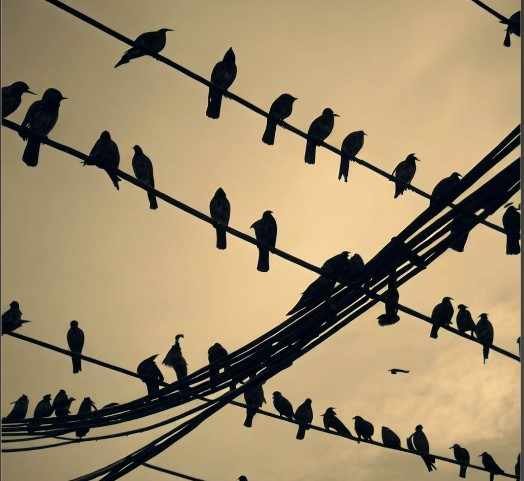Why Birds Don’t Get Shock – Birds, those graceful creatures of the sky, possess extraordinary abilities to navigate vast distances, survive in challenging environments, and maintain an exquisite balance with nature. Among the many wonders of avian life is their uncanny ability to avoid electric shocks, despite their interactions with electrical fields on numerous occasions.
1. Why Birds Don’t Get Shock
Unlike humans, who must exercise caution around electricity, birds seem almost indifferent to its presence. In this article, we will delve into the fascinating world of avian adaptations and explore the reasons why birds don’t get shocked.
- The Amazing Avian Adaptations
- 2.1 Feathers: Nature’s Insulators
- 2.2 Hollow Bones: Reducing Conductive Pathways
- 2.3 Unique Muscle Structure: Decreasing Electrical Flow
- Understanding Bird’s Nervous System
- 3.1 The Role of Neurons
- 3.2 Electroreception in Birds
- Bird’s Feet and Perching Abilities
- 4.1 The Miracle of Perching
- 4.2 Feet Structure and Insulation
- Birds and Lightning Strikes
- 5.1 How Birds Cope with Lightning
- 5.2 Lightning’s Rare Impact on Birds
- Birds vs. Power Lines
- 6.1 Avoidance Behaviors
- 6.2 Power Line Designs and Bird Safety
- The Evolutionary Perspective
- 7.1 Natural Selection and Survival
- 7.2 Adapting to Electrical Environments
- Interactions with Electrical Storms
- 8.1 Bird’s Electromagnetic Sensitivity
- 8.2 How Birds Respond to Storms
- Electromagnetic Fields and Bird Migration
- 9.1 The Mystery of Navigation
- 9.2 Magnetic Compass and Bird Migration
- Human Influence on Bird Electromagnetic Sensitivity
- 10.1 Urbanization and EMF Exposure
- 10.2 Bird Behavior Near Human Technology
- Conclusion
- FAQs
The Amazing Avian Adaptations
2.1 Feathers: Nature’s Insulators
Feathers are not just for flying, they also play a crucial role as insulators. These lightweight structures cover a bird’s body, acting as a protective barrier against external electric currents. The unique structure of feathers helps distribute electric charges evenly, preventing shocks from affecting the bird’s nervous system.
2.2 Hollow Bones: Reducing Conductive Pathways
Birds have evolved with hollow bones, reducing their weight for flight efficiency. Interestingly, this adaptation also helps decrease the surface area for electrical conductivity. As a result, the likelihood of electric shocks significantly diminishes.
2.3 Unique Muscle Structure: Decreasing Electrical Flow
The muscles in a bird’s body are designed to minimize electrical flow. This design not only conserves energy during flight but also serves as another protective mechanism against shocks. The lower electrical resistance in their muscles ensures that any potential currents are rapidly dispersed.
Understanding Bird’s Nervous System
3.1 The Role of Neurons
Birds have a complex nervous system responsible for various sensory perceptions. While they may not be highly sensitive to electrical fields, their neurons play a vital role in maintaining their motor skills and coordination.
3.2 Electroreception in Birds
While not all birds possess this ability, some species have electroreceptors in their beaks. These specialized sensory organs allow them to detect weak electrical signals generated by prey hiding beneath sand or mud, aiding in their foraging activities. However, the same receptors seem to have limited sensitivity to external electrical fields.
Bird’s Feet and Perching Abilities
4.1 The Miracle of Perching
Birds’ feet are specially adapted to allow them to perch effortlessly on various surfaces, including power lines. This unique talent is attributed to a combination of tendons, ligaments, and grip strength, which enables birds to maintain balance without creating a conductive path for electric currents.
4.2 Feet Structure and Insulation
The structure of a bird’s feet plays a vital role in preventing shocks. Their feet are covered with thick, non-conductive scales, providing insulation against electrical currents. This adaptation safeguards the bird while perching on potentially electrified surfaces.
Birds and Lightning Strikes
5.1 How Birds Cope with Lightning
Birds face a higher risk of lightning strikes due to their frequent presence in the open sky. However, they possess exceptional reflexes, allowing them to take evasive actions swiftly. Additionally, the insulating properties of their feathers and hollow bones provide some level of protection during lightning storms.
5.2 Lightning’s Rare Impact on Birds
Despite the potential risk, lightning strikes on birds are relatively rare. Their ability to sense atmospheric changes likely contributes to their successful avoidance of hazardous situations during storms.
Birds vs. Power Lines
6.1 Avoidance Behaviors
Birds have developed avoidance behaviors around power lines to minimize the chance of electric shock. They are known to alter their flight paths and actively avoid close contact with live wires.
6.2 Power Line Designs and Bird Safety
Power line designers and engineers have taken bird safety into account when designing structures. Insulation measures, bird diverters, and other modifications are employed to reduce bird fatalities due to electrical accidents.
The Evolutionary Perspective
7.1 Natural Selection and Survival
Throughout evolution, birds that exhibited traits promoting survival in their respective environments were more likely to pass on their genes. The ability to withstand electrical fields could have offered a significant advantage, leading to the development of electro-resistant characteristics in avian anatomy.
Also Read - 50 Amazing Facts for School Assembly
7.2 Adapting to Electrical Environments
As human activities increasingly introduce artificial electrical fields into the environment, birds may continue to adapt to these new challenges. Future generations could exhibit even greater resistance to electric shocks.
Interactions with Electrical Storms
8.1 Bird’s Electromagnetic Sensitivity
Birds’ electromagnetic sensitivity is thought to play a role in navigation and detecting environmental changes. However, their ability to sense electrical fields is still not fully understood.
8.2 How Birds Respond to Storms
During electrical storms, birds may alter their behavior, seeking safer locations until the storm subsides. Their response may involve adjustments in flight patterns or seeking sheltered areas.
Electromagnetic Fields and Bird Migration
9.1 The Mystery of Navigation
Bird migration is one of nature’s great mysteries. While various factors contribute to their navigation skills, it’s believed that electromagnetic fields play a part in helping them find their way during long-distance journeys.
9.2 Magnetic Compass and Bird Migration
Research suggests that birds may use Earth’s magnetic fields as a compass to aid them in their migratory routes. This remarkable ability allows them to traverse thousands of miles with remarkable accuracy.
Human Influence on Bird Electromagnetic Sensitivity
10.1 Urbanization and EMF Exposure
As urban areas expand and technology advances, birds encounter an increasing number of electromagnetic fields from power lines, cell towers, and other sources. Understanding how these fields impact birds becomes crucial in mitigating potential risks.
10.2 Bird Behavior Near Human Technology
Observing how birds behave near human technology sheds light on their adaptability and potential resilience in the face of rapidly changing environments.
Conclusion – Why Birds Don’t Get Shocked
The electrical resistance of birds is an awe-inspiring adaptation that allows them to coexist harmoniously with electricity, unlike many other living creatures. From their feathered insulation to their unique muscle structure, birds have evolved various ways to avoid electric shocks. As we continue to study and appreciate these remarkable avian abilities, let us also remember the importance of protecting their habitats and ensuring a safe environment for them to thrive.
FAQs – Why Birds Don’t Get Shock
1 Do birds feel any electrical sensations at all?
While birds may have some level of sensitivity to electrical fields, they do not experience electric shocks as humans do due to their remarkable adaptations.
2 How do birds build nests on power lines without getting shocked?
Birds’ nests on power lines do not create a closed circuit, ensuring they are not in direct contact with live wires.
3 Can bird behavior predict electrical storms?
The long-term effects of electromagnetic radiation on bird populations are still being studied. It’s essential to research and mitigate potential risks to bird species.
5 How do bird species differ in their sensitivity to electrical fields?
Bird species may exhibit varying levels of sensitivity to electrical fields based on their evolutionary history and environmental adaptations.





















[…] Why Birds Don’t Get Shock – Unraveling the Electrical Resistance of… […]